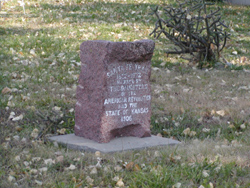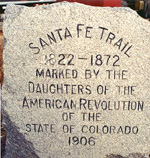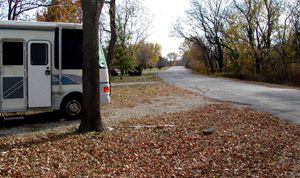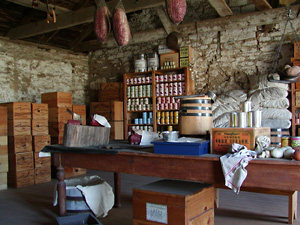|
In 1821 Missouri became the 24th state to
be admitted to the United States. That same year, William
Becknell and his party loaded a pack train with goods to
travel west and trade with the Indians. Little did he know
how his plans would change and what momentous impact it
would have on the future of the United States.
Not finding any Indians, they turned southwest towards
Spanish territory. Near the Canadian River, they were
approached by Mexican soldiers. Expecting arrest, they were
surprised to learn of Mexico's independence from Spain, and
were invited to Sante Fe to trade with local Mexicans.
They were rewarded with profits from trading on the order of
fifteen-hundred percent!
The Becknell party returned to Franklin, Missouri with their
newly found fortune, only to begin planning another venture
the following year.

|
 In
1906, In
1906,
members of the
D.A.R. would
mark the
entire Sante Fe
trail with these
stone markers.

|
|

Renee photographs very faint
trail ruts
near Overbrook, Kansas. Ruts found farther
to the west would be much deeper.
Here are much deeper trail ruts found near Larned, KS.

|
In 1822 he returned to Sante Fe, this time using wagons
instead of the horses and pack mules of the year before. The
wagons were simply able to carry far more goods. In fact,
future freight wagons designed specifically for the Sante Fe
trail would carry as much as 3 tons of goods. These great
wagons would etch trails so deep and vast that their paths
would be easily followed for the next 2 centuries, first by
other traders, and eventually by those interested only in
following in the footsteps of their forefathers.
Normally, most traders were able to make the
trip to Sante Fe and back in the same year. The trail was
actually in use from 1821 until 1880, when the arrival of
the railroad in Sante Fe spelled doom for the trail.
Contrary to what might be expected, it was the early years
that often proved safer for travel, although any travel in
those years could not be considered safe by today's
standards.
|
|
Today, the Sante Fe trail
is easy to find, and in many places follow. In 1906, members
of the D.A.R. traveled the entire length of the
trail, identifying it in various places with stone markers. Many
very good trail guides have also been published, one of the
best being Marc Simmons' excellent guide, "Following the
Sante Fe Trail". Most state and national maps show the path
of the trail as it crosses Kansas, Oklahoma, Colorado, and
New Mexico. Any town of good size in those states will offer
museums with often outstanding displays and information
about the trail years. An especially good museum can be
found in Larned, Kansas at the Sante Fe Trail Center, just
east of town on highway 156. A "must see" museum.
identifying it in various places with stone markers. Many
very good trail guides have also been published, one of the
best being Marc Simmons' excellent guide, "Following the
Sante Fe Trail". Most state and national maps show the path
of the trail as it crosses Kansas, Oklahoma, Colorado, and
New Mexico. Any town of good size in those states will offer
museums with often outstanding displays and information
about the trail years. An especially good museum can be
found in Larned, Kansas at the Sante Fe Trail Center, just
east of town on highway 156. A "must see" museum.
|

The view out
"Annabelle's
window
at Council Grove
lake.
|
|
Travelers faced dangers from severe weather, shifting
quicksand, marauders, and hostile Indians. The danger from
the Indian nation became especially severe after 1864,
nearly closing the trail from use.
The weather encountered on the open plains was something new
for travelers. Many were surprised by the speed at which
storms could develop. Consider this chronicle of events
reported by Don Manual Alvarez in 1841.
"On the 24th [of November] reached the Cotton-woods
fork and found two of the four men who had started in
advance for Missouri; the other two having continued. Same
night had a severe snow storm, which continued for 48 hours
with such violence we were unable to keep a fire. Snow 3
feet deep, we were all more or less frozen.
|

"Annabelle" takes a
break
The Council Grove Lake
campground is
a beautiful and virtually unknown site.
In two trips, one in October 2000 and
the second in October 2001, Renee and Jim
counted only three other campers total.
This in a campground designed for around 200!
|
|

Two more views
of the
Council Grove
Lake campground
|

|
|
27th one of the two men who had started in advance, returned
to the camp badly frozen, and reported that his comrade,
John Richmirs, had frozen to death four miles from the place
of our encampment. Mr. South being so badly frozen as to be
unable to travel, and one other of our men being sick, I
concluded to leave them in camp with a man to take care of
them, until we could send them aid from the settlements. The
storm was so severe that many of my animals perished."
The loss of many animals in this party was not unique. Some
travelers would loose all of their animals, placing the
wagon train in great peril
The threat of attack
by various Indian groups was very real throughout the
history of the trail, but more so in the later years than
the early. Some travelers reported the Native Americans they
encountered as tricksters, always looking to pull "a fast
one" on unsuspecting folks. Others portrayed the Indians in
a manner we might find surprising as reported by Ernestine
Franke Huning in her diary of 1863:
May 6 "We meet Indians very often now, some have
their faces painted. Naturally they have a dark complexion.
All are very tall, well built. They always beg, but are
satisfied when they get something to eat, and go. We saw one
of their houses made of branches with a hole in the middle
for the smoke to go out, as they cook by making a fire
inside."
Not all encounters were as uneventful, as witnessed by the
account of one James M. Fugate in 1853. His large and well
armed wagon train was repeatedly attacked over several days.
Many of the wagon train party were killed and over a hundred
Indians lost their lives. The group's first battle occurred
on May 21st and they engaged in fights on many days,
sometimes with as many as 500 hostiles until arriving in
Sante Fe itself. Over a period of several weeks they fought
the Comanches, Cheyennes, Apaches, and Arapahoes.
|

Fort Larned,
Kansas today, one of two well maintained forts along the
Sante Fe Trail, the other being Fort Union in New Mexico.
The fort has been restored to it's trail day appearance
complete with weapons, supplies and operating facilities. It
has some of the best museum items and living displays found
anywhere along the trail. With The Sante Fe Trail Center
also located in the immediate area outside Larned, KS this
is a must stop for anyone following the history of the
trail.

Ft. Larned graffiti dated 1877
|
|

Two
more
views of
Fort Larned
located near
Larned, KS.
The fort has been
faithfully
restored to it's
1800's form,
complete with
requisite supplies.
|

|
|

|
Some Sites to Visit
Sante
Fe Trail Association
Larned,
KS Community Page
Sante
Fe Trail Center
Museum
Back
to Top
|
|
Recognizing the importance of keeping the trail open, the
United States established a series of forts along the trail,
Ft. Larned in 1859, Ft. Lyon in 1860, Ft. Union in 1861 and
1862, and Forts Dodge and Zarah in 1864. With increased army
presence in the area, hostile activities came to an end
around 1869. On February 16, 1880 the first train rolled
into Sante Fe, spelling the end of the trails use as a
commercial highway.

Jim and Renee wish to thank the
state of Kansas and it's people for their warm hospitality
during our several trips, and for making the effort to
preserve an important but rapidly disappearing piece of
American history. Very little remains of the original Sante
Fe Trail, and in another hundred years the only trace left
may be the photographic images taken by all those interested
in the trail's preservation.
For those of you who have maligned the state based on the
more desolate sections found along I-70 in the more northern
part of the state, you should reserve final judgment of the
beauty to be found here until you have driven highway 59
through southeast and south central
Kansas.........................jim and
renee
|
Books
Books about the Sante Fe Trail are too numerous to list, but
several that made our searching possible and enjoyable
were:
"Following the Sante Fe Trail"
by Marc Simmons
"The Sante Fe Trail: New Perspectives"
compiled by the Colorado Historical Society
"The Sante Fe Trail: Yesterday and Today"
by William E. Hill
Two memoirs that should be read
by everyone interested in the trail are:
"Land of Enchantment: Memoirs
of Marian Russell"
as retold to her daughter-in-law Mrs. Hal Russell with a
foreword by renown trail expert, Marc Simmons.
"Down the Sante Fe Trail and into Mexico"
the diary of Susan Shelby Magoffin 1846-1847, likely the
most cited diary of the period.
In addition to the titles
above, the following was used as the source of much of the
story told herein:
"On The Sante Fe Trail"
a collection of various manuscripts collected and edited by
Marc Simmons. Without his writings, we would know far less
about the history of the trail.
As you visit the various museums along the trail, be
prepared to part with much money as you find volume after
volume of fascinating
reading.
|
|
|
|
|
|
|
|
|
|



 In
1906,
In
1906,











